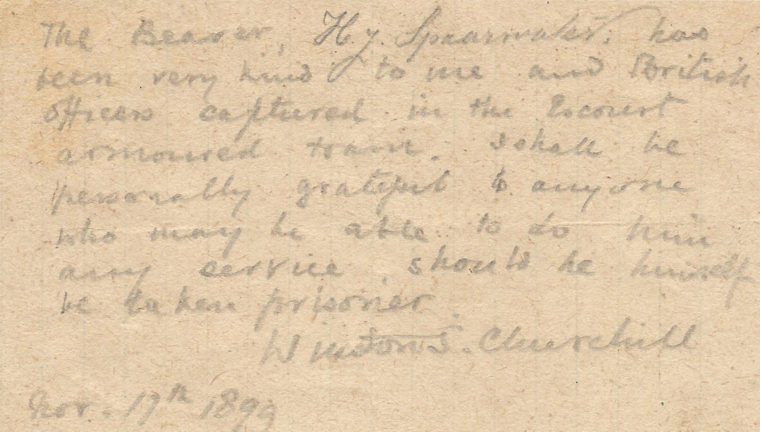The below piece was first published on Nathan Raab’s blog on Forbes at https://www.forbes.com/sites/nathanraab/2017/05/18/the-8000-mile-118-year-journey-of-winston-churchills-pow-letter
The 8,000-Mile Journey Of Winston Churchill’s POW Letter
Winston Churchill, a prisoner of war, took from his pocket a small pad of paper, and scribbled a note to his captor. He had been treated well in captivity and wanted people to know it in case the tables turned and his captor ended up behind English bars. Wait. Churchill was a prisoner of war? You don’t remember the story of his capture by the Nazis in World War II? The future Prime Minister’s capture and heroic escape, which launched him to fame, actually took place 40 years before that war, when he was just 24 years old and trying to make a name for himself. The ambitious Churchill sought out conflict to cover it as a writer, arriving in South Africa to witness firsthand the Boer War, a brutal colonial conflict between England and the descendants of the original Dutch settlers there, the Boers. Almost as soon as he arrived, he was captured. But this post is not about 1899. Nor is it a history of the era or the war or even the man. It is a story 118 years in the making, the story of one sheet of paper.

“The bearer, Mr HG Spaarwater, has been very kind to me and the British officers captured in the Escort armoured train. I shall be personally grateful to anyone who may be able to do him any service should he himself be taken prisoner. Winston S Churchill.” So Churchill wrote hastily in the notepad. He dated it November 17, 1899 and handed it to Spaarwater, his captor.
Here, Churchill and his note parted ways, with the man heading to a more permanent imprisonment and the paper accompanying Spaarwater, who headed back to the front lines. He never got a chance to use it. A year later, he was killed in a friendly fire incident, and his belongings returned with his body back to the small rural town, hundreds of miles from any major city, where he lived. The note now had a new owner: his heirs, who kept it and continued to pass it down. Two generations later, the note passed to a museum, when Spaarwater’s granddaughter decided the time had come to sell it. Here, at this museum, in a village located nearly equidistant between Johannesburg, Lesotho, Swaziland, and the Indian Ocean, this piece of paper joined other artifacts from the Boer Wars on display for the occasional visitor or historically interested tourist who wished to see it.
We find historical artifacts all over the world but sometimes the artifacts find us. Fast forward two decades and my firm, The Raab Collection, received an email from the owner, mentioning the letter and asking us what we thought. She too had decided it was time to part with the piece, and we agreed to buy it. We settled on a purchase price but there was another complication: how to get the letter from a ranching district in Sub-Saharan Africa to the Main Line of Philadelphia. The solution: she got in her car and drove 300 miles to get to the Fedex office in Johannesburg. Then 300 miles back.
But Churchill’s note’s journey had not ended yet. It had two days left to go on board 3 different planes before the Fedex delivery man knocked on my door and handed me the package.
For those who reflect on how history is written and preserved, reflect on this: It took no fewer than 6 people located in two countries in two different hemispheres across a vast ocean to ensure this piece of history survived to be written about: Churchill (who wrote it), HG Spaarwater (who received and kept it), his children (who recognized its importance), his granddaughter (who passed it on when she felt it needed a new home), the museum owner (who preserved and displayed it), Fedex (who safely transported it), and The Raab Collection, all of which took place over a span of 118 years and more than 8,000 miles.
Now the note’s journey continues: it was sold to a serious private collector in Florida, who will take up this task himself, as the letter leaves one owner and joins yet another.






































































































